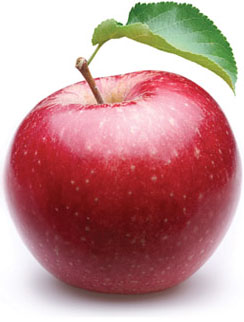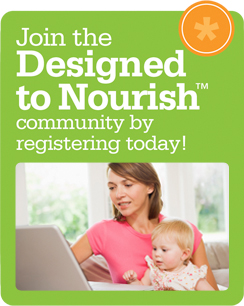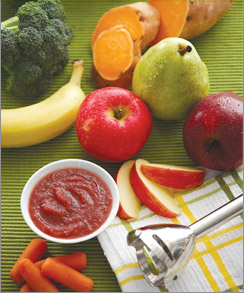Please note that this information is offered as a guide, but is not the rule. Each baby is unique in development, which is why it is important to follow your child’s cues and consult your pediatrician before introducing new foods.
| Stage 1 |
Stage 2 |
Signs Of Readiness
Around six months of age- baby is hold his head up and is no longer thrusting his tongues to push food out of his mouth.
What To Feed
Breast milk or formula and cereal
Food Suggestions
Try introducing iron-fortified rice cereal mixed with breastmilk or warm formula.
Serving Size Suggestions
Feed small servings. Infants will stop eating when they are full and need to be given the chance. One to two spoonfuls may be all they need to begin with. |
Signs Of Readiness
Baby is holding his head up, able to sit up on his own and is no longer thrusting his tongue to push food out of his mouth.
What To Feed
Single pureed/strained food
Food Suggestions
Introduce new solid food gradually and one at a time to gauge baby’s reaction and possible food sensitivities. Include: avocado, banana, carrots, green beans, peaches and sweet potato.
Serving Size Suggestions
Baby will only eat one or two teaspoons in a sitting, two to three times a day. This will gradually increase and it will be crucial to read baby’s hunger cues.
|
| Stage 3 |
Stage 4 |
Signs Of Readiness
Approximately two to three months after starting solid foods. By this time, you have tested food one at a time for sensitivity and baby is increasing portion sizes.
What To Feed
Pureed or mashed combination foods
Food Suggestions
Strawberries and Oatmeal, Pork, Carrots and Applesauce and Turkey and Gravy.
Serving Size Suggestions
Daily food should increase to:
- 1/3 cup yogurt or 1/2 ounce cheese
- 1/4 to 1/2 cup iron-fortified cereal
- 1/4 to 1/2 cup vegetables
- 1/8 to 1/4 cup protien foods
- 3 to 4 ounces non-citrus juices or fruit
|
Signs Of Readiness
Around eight- to ten-months-old-picks up objects with thumb and forefinger, has more teeth.
What To Feed
Chopped/easy-to-chew foods
Food Suggestions
Pumpkin Mac & Cheese, Crispy Cheese Crackers and Whole Wheat Graham Crackers
Serving Size Suggestions
Daily food for toddlers should be broken up into five or six small meals or snacks
 |
| Stage 5 |
Signs Of Readiness
Around eighteen-months-old-toddler can eat with a spoon.
What To Feed
Easy-to-eat foods
Food Suggestions
Steamed Vegetables; Bow Tie Chicken Soup, Spinach Shapes, Breakfast Wrap and Goofy Eggs.
Serving Size Suggestions
A good rule of thumb used to determine serving size is offering around one tablespoon of a food item per year of age |


